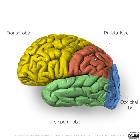insular cortex





The insular cortex, or the insula, lies deep to the lateral surface of the brain, completely covered by the frontal, parietal, and temporal opercula. It accounts for approximately 2% of the cortical surface.
Terminology
The insular cortex has been described in the medical literature as a separate lobe of the telencephalon (the "fifth lobe") or as a part of other structural or functional groupings. Most would refer to it as a distinct area (i.e. not belonging to any of the neighboring lobes), but not as a lobe.
Gross anatomy
The insular cortex lies deep to the lateral sulcus (Sylvian fissure), which separates the frontal and parietal lobes dorsally from the temporal lobe ventrally. The overlying cortical areas formed by the frontal, parietal, and temporal lobes are known as opercula (meaning "lids").
The insula is shaped like a sessile irregular pyramid, with its trapezoid base facing medially. The base is circumscribed by the circular sulcus, although, more precisely, it is bounded by four peri-insular sulci: anterior, inferior, superior, and posterior . The apex points laterally into the Sylvian fissure. The insular cortex is divided into two lobules, anterior and posterior, by the central sulcus of the insula, which passes obliquely from posterosuperior to anteroinferior.
The anterior lobule has a "pole" which denotes the anteroinferior-most point. Its surface is divided obliquely, roughly parallel to the central sulcus of the insula, but converging inferiorly, usually as three short gyri . As such, the anterior lobule somewhat resembles the letter "W".
The posterior lobule is divided obliquely, parallel to the central sulcus of the insula, by two long gyri which converge anteroinferiorly at what is sometimes referred to as the "pole" of the posterior lobule . As such, the posterior lobule somewhat resembles the letter "Y" or "V".
Blood supply
The insula is supplied by perforating branches from the middle cerebral artery (MCA), usually from the M2 segment .
Neurophysiology
The insula has a number of disparate functions, serving as the primary gustatory cortex, as well as having important connections to language and visual-vestibular integration . Additionally, it also has important autonomic function, particularly sympathetic tone from the right insula; damage to this area has been associated with cardiac arrhythmias .
Radiographic features
CT
Due to tenuous collateral supply, the insula is prone to early cytotoxic edema in acute embolic stroke involving the middle cerebral artery, leading to the loss of insular ribbon sign .
History and etymology
The insular cortex is also known as the island of Reil, named after German anatomist, physiologist and pioneer psychiatrist Johann Christian Reil (1759-1813) . In Latin, insula means "island".
Siehe auch:
und weiter:

 Assoziationen und Differentialdiagnosen zu Inselrinde:
Assoziationen und Differentialdiagnosen zu Inselrinde:

